The Art of Power The Royal Armoury and Court Portraiture
The itinerary <em>TITULORECORRIDO</em> has been successfully created. Now y'all can add together in works from the Collection browser
<em>TITULOOBRA</em> added to <em>TITULORECORRIDO</em> itinerary
The Art of Power. The Royal Armoury and court portraiture
Madrid three/9/2010 - 5/23/2010
The exhibition offers an infrequent opportunity to see an important pick of works from the Prado displayed for the first time alongside the collection of armour belonging to Patrimonio Nacional. This is an unprecedented concept for an exhibition and one that establishes a direct comparison between the court portraits painted past leading masters such as Titian and Rubens and the armour worn by Spanish monarchs that symbolised their ability at the height of that monarchy's splendour.
Following the exhibitionThe Art of Power. Royal Armor and Portraits from Imperial Spain, held at the National Gallery of Fine art, Washington, in 2009, in 2010 the Museo del Prado showsThe Art of Power. Arms, Armour and Paintings from the Spanish Court. The exhibition comprises an outstanding pick of objects loaned past the Royal Armoury in Madrid, displayed alongside a major grouping of paintings that reveal how the nifty painters of the day emphasised artillery and armour when representing the ability of the Spanish monarchy from the Renaissance onwards. The Fine art of Power. Arms, Armour and Paintings from the Castilian Court provides a unique occasion to meet a grouping of masterpieces that could only be brought together in the Prado, gear up within the context of the armed portrait.
Founded at the height of the Spanish monarchy's international power and splendour, the Majestic Armoury in Madrid is the oldest and one of the finest and near comprehensive in the globe. Largely built upward by the Emperor Charles 5 (1500-1558) and his son Philip Two (1556-1598), it houses non only the personal arms and armour of the Castilian monarchs but also a number of military machine trophies and diplomatic and family gifts.
The exhibition takes the form of anintroductory department and four monographic ones, entitledThe Court Portrait and the Armouries of Charles and Philip II,The Absence of Portraits in Armour in the 2nd one-half of the 16th century and their Revival under Philip III prior to his Accession,The Royal Armoury in 17th-century Court Painting, andThe Bourbon Armed Portrait: the French and Spanish Tradition. Overall, the exhibition offers a wide overview of the issues pertaining to the relationship between armour and painting. Along with the 35 paintings and 27 pieces of armour that establish the cadre of the exhibition, visitors can besides run into a tapestry, medals and sculptures that further explain the connections betwixt the two main groups.
- Curator:
- Álvaro Soler del Campo
Opening time
Tuesdays to Sundays, from 9am to 8pm. Closed to the public every Mon.
Multimedia
Exhibition
Introduction
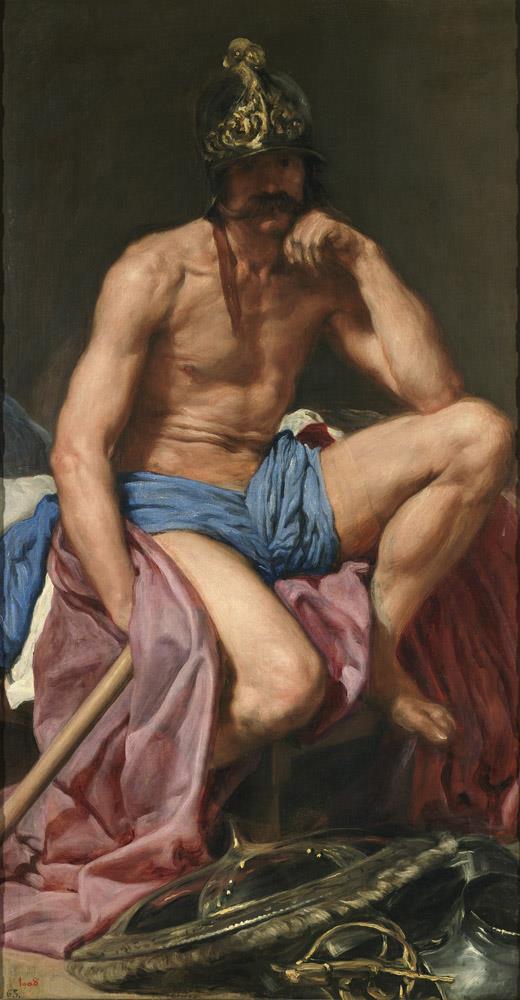
-
- Mars
- Diego Velázquez
- Oil on canvas, 179 x 95 cm. c. 1641
- Madrid, Museo Nacional del Prado
The exhibition opens with an introductory room that aims to explicate the importance of majestic collections of armour and painting at the Renaissance and Baroque courts as well as ideological and thematic connections. Notable exhibits in this room include the Parade Helm of Charles V with the symbol of the Gilded Fleece, an object that emphasises the monarch's position as Yard Master of that prestigious chivalrous Order, and the Burgonet of Charles 5, symbolising the victory of Christianity over Islam. These objects are seen alongside paintings past Velázquez, Rubens and Teniers. Also on display, and indicative of the close link betwixt armour and paintings as symbols of imperial power, are documents with the orders given to the Royal Armoury to allow Velázquez and Rubens admission in order to copy details of arms and armour.
The Court Portrait and the Armouries of Charles V and Philip II
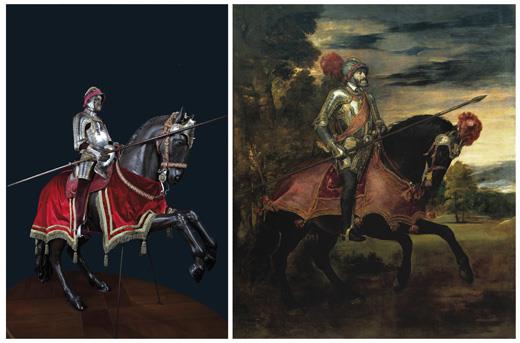
-
- Emperor Charles V on Horseback at Mühlberg.
- Titian
- Oil on canvas, 335 x 283 cm. 1548
- Madrid, Museo Nacional del Prado
- Charles V Armour called Mühlberg
- Desiderius Helmschmid. Embossed, engraved and gilt steel. Augsburg 1544
- Madrid, Patrimonio Nacional, Real Armería.
The first section analyses the influence of the armouries of Charles V and Philip II (prior to his accession) on the court portrait. Information technology volition introduce the visitor to the ascension and splendour of the armed portrait, a genre that was closely associated with the triumphant image of the Spanish monarchs as victors in war and during their majestic and opulent trips to Italian republic and Germany. Suits of armour such equally the one worn past Charles 5 at the Boxing of Mühlberg (made in 1544 by Desiderius Helmschmid), together with Titian's impressive portrait of the Emperor, or the Burgundian Cross worn by Philip Two at the Battle of Saint Quentin (made by Wolfgang Grosschedel) and its inclusion in Anthonis Mor'south portrait, signal the symbolic importance of these objects.
The Absence of Portraits in Armour in the second half of the 16th century and their Revival under Philip III prior to his Accretion
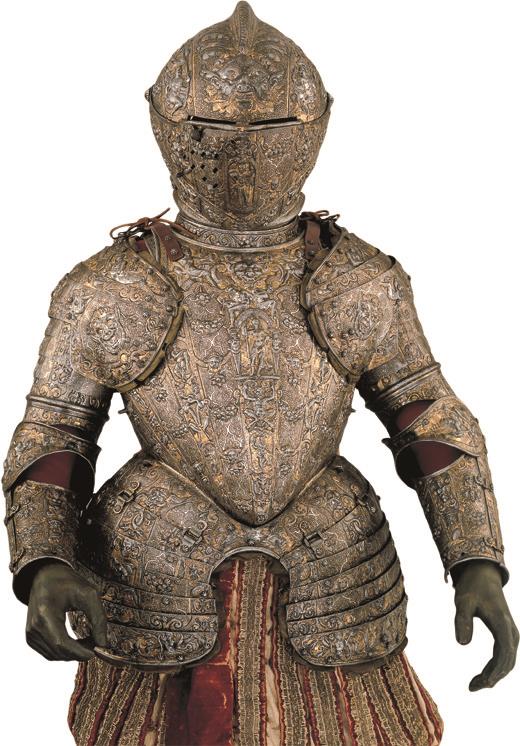
-
- Child Armour of Philip Three.
- Engraved, embossed and gilt steel, aureate and argent damascened. Milan c. 1585
- Madrid, Patrimonio Nacional, Existent Armería.
The second section of the exhibition looks at Philip II's new use of the armed portrait with respect to its before manifestations. The king either favoured the classical paradigm alla romana with its heroic connotations, or the apply of courtroom apparel, except in compositions relating to the Boxing of Lepanto. These concepts are illustrated through objects such as the Parade Armour of Philip II, a suit of ceremonial armour that is exhibited next to Leone Leoni's sculpture, and the Helmet of Ali Baja, a bays from the Battle of Lepanto, shown alongside Titian'southward painting that commemorates that victory. Royal armour was not deputed for much of Philip Ii'southward reign, just at that place was a revival of this art form arising from the dubiety surrounding Philip III'due south survival as the last possible heir in the dynastic succession. This revival saw the creation of a series of portraits in armour associated with Philip taking the adjuration as Prince of Asturias, for instance, the portraits by Pantoja de la Cruz and Justus Tiel, which are displayed next to child armour made by Lucio Marliani and Pompeo della Cessa. The tradition was continued during the reign of Philip 4 in works such equally the Portrait of Philip IV with two Servants by Gaspar de Crayer, in which the monarch is depicted in the formalism armour sent to him in 1626 by Isabel Clara Eugenia.
The Royal Armoury in 17th-century Courtroom Painting
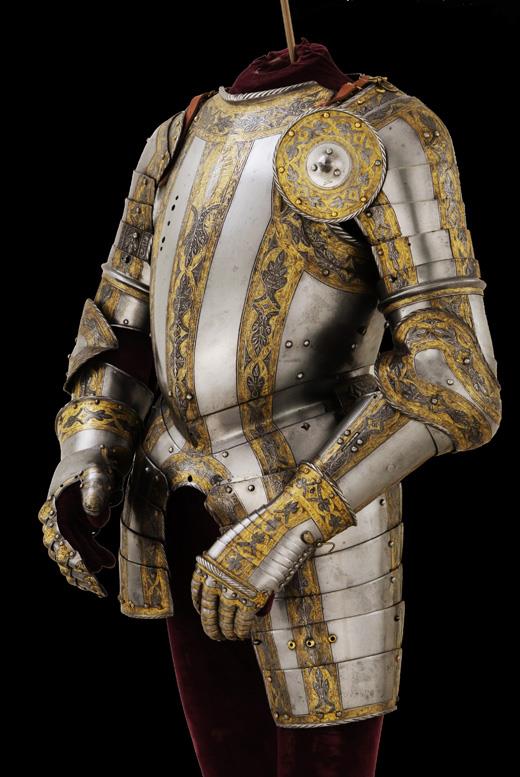
-
- Blossom Pattern Armour.
- Desiderius Helmschmid
- Embossed, engraved and gilt steel. Augsburg c. 1550
- Madrid, Patrimonio Nacional, Existent Armería.
The third department, entitled The Royal Armoury in 17th-century Court Painting, shows the different phases in the relationship between the collection of the Royal Armoury in Madrid and the court portrait, ranging from its close links with the image of purple power to its use as a mere repository of motifs applicative to different types of painting from the second third of the 17th century onwards. During that menstruation armour and the style it had been used past Charles Five and Philip Ii to convey symbolic notions of power continued to be a source of inspiration for a number of court portraits (such as Philip Two on Horseback by Rubens, and Charles II in Armour by Carreño de Miranda). At this period, nonetheless, we meet the holdings of the Armoury beingness used as accessories in portraits of nobles such every bit the Count of Benavente by Velázquez, that of the second Marquis of Santa Cruz at the Relief of Genoa by Pereda (a recently restored sail), and the image of the Count Duke of Olivares seen in The Recapture of Bahía in Brazil by Maíno. The sitters in these compositions appear wearing armour from the Felicísimo Viaje and with the ceremonial sword of the Catholic Kings.
The Bourbon Portrait in Armour: the French and Castilian Tradition
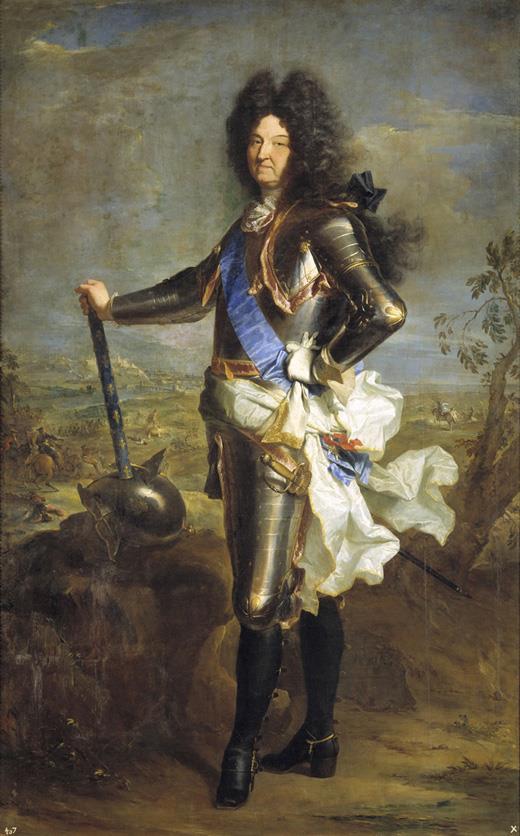
-
- Louis Fourteen.
- Hyacinthe Rigaud
- Oil on canvas, 238 x 149 cm. 1701
- Madrid, Museo Nacional del Prado.
The concluding section of the exhibition looks at the ascent to the throne of Philip V, a monarch who combined the French taste for the portrait in armour with the Castilian Habsburg tradition. The most telling example of this fusion is the anonymous portrait of the new monarch equally a immature human being wearing Philip Two'south armour that had once been depicted by Titian. This section also includes portraits of Ferdinand VI in role-armour past Jean Ranc, and that of Charles III by Mengs, which is the last example of a portrait of a Castilian monarch in armour and the final work in the exhibition.
Artworks
1
Parade Helmet of Charles V
Filippo Negroli
Embossed, chassed and gilded steel, 29,5 x 26,4 x 34,1 cm. Weight 2355 gr
Milan 1533
Madrid, Patrimonio Nacional, Real Armería
iv
Helmet of Charles V
Desiderius Helmschmid
Embossed, engraved and golden steel, 28,two x 21,v 10 26,5 cm. Weight 1925 gr
Augsburg 1540
Madrid, Patrimonio Nacional, Real Armería
5
Apotheosis of Charles V Shield
Steel, gold and silver, 53,viii cm bore. Weight 2970gr
Italia c. 1535-1540
Madrid, Patrimonio Nacional, Real Armería
6
Burgonet of Charles V
Filippo and Francesco Negroli
Embossed, chassed, bronzed and gilt damascened steel, 25 x 23 10 35,vii cm. Weight 2130 gr
Milan 1545
Madrid, Patrimonio Nacional, Existent Armería
7
Medusa Shield of Charles 5
Filippo and Francesco Negroli
Embossed, chassed and damascened steel, 59,2 cm diameter. Weight 4700 gr
Milan 1541
Madrid, Patrimonio Nacional, Existent Armería
eleven
Charles Five Aged Seven with a Sword
Anonymous
Oil on panel, lx x 42,5 cm
c. 1508
Innsbruck, Schloss Ambras, Porträtgalerie
12
Fleur-de-lis Scroll Armour of Charles V
Kolman Helmschmid
Embossed, engraved and gilt steel
Augsburg c. 1525 - 1530
Madrid, Patrimonio Nacional, Real Armería
13
Charles V
Giovanni Britto co-ordinate to Titian
Coloured engraving, 481 x 353 mm
1536
Vienna, Graphische Sammlung Albertina
fifteen
Armour of Charles V called Mühlberg
Desiderius Helmschmid
Engraved, embossed and gilt steel
Armour and helmet
Chaffron: 65 ten 27 cm. Weight 14850 gr
Augsburg 1544
Madrid, Patrimonio Nacional, Existent Armería
17
Gun belonging to Charles V
Peter Pech
Steel, fe and forest, 8 x half-dozen,eight cm; caliber 15 mm. Weight 1655 gr
Munich c. 1545 - 1550
Madrid, Patrimonio Nacional, Real Armería
xviii
Review of the Troops at Barcelona (2d console in the Conquest of Tunis series)
Willem de Pannemaker, January Cornelisz Vermeyen and Pieter Coecke van Aelst I
Golden, silver, silk and wool, 532 ten 715 cm
Brussels Brabant c. 1554
Madrid, Patrimonio Nacional, Palacio Real
20
Charles V in Armour
Juan Pantoja de la Cruz according to Titian
Oil on canvass, 181,5 x 96 cm
1608
El Escorial, Patrimonio Nacional, Real Monasterio de San Lorenzo
21
Helmet of the Mühlberg Armour
Desiderius Helmschmid
Embossed, engraved and aureate steel, 28,2 10 21,5 ten 26,v cm. Weight 1925 gr
Augsburg 1544
Madrid, Patrimonio Nacional, Real Armería
22
View of the Entourage of Charles II in front of the Alcázar in Madrid
Spanish Bearding
Oil on canvas, 74,8 x 112,eight cm
c. 1685
Madrid, Colección Abelló
23
Armour and Burgonet called the Flower Blueprint
Desiderius Helmschmid
Embossed, engraved and gilded steel
Augsburg c. 1550
Madrid, Patrimonio Nacional, Real Armería
27
Armour, Shield and Helmet of Philip Two
Desiderius Helmschmid
Bronzed, gilt and damascened steel, gilded, brass and leather
Shield, 55,v cm diameter. Weight 4580 gr
Helmet, 55 10 24 cm. Weight 1360 gr
Augsburg 1549 - 1550 and 1552
Madrid, Patrimonio Nacional, Real Armería
28
Armour of Philip II Called the Cantankerous Harness
Wolfgang Grosschedel
Engraved and gilt steel, gilt and brass
Landshut 1551
Madrid, Patrimonio Nacional, Real Armería
29
Philip 2 on the Day of Saint Quentin
Antonio Moro
Oil on sail, 200 x 103 cm
1560
El Escorial, Patrimonio Nacional, Real Monasterio de San Lorenzo
31
Cenotaph of Charles 5 and his Family unit
Juan Pantoja de la Cruz
Oil on canvas, 177 x 161 cm
1599
El Escorial, Patrimonio Nacional, Real Monasterio de San Lorenzo
32
Cenotaph of Philip Ii and his Family
Juan Pantoja de la Cruz
Oil on canvas, 177 ten 161 cm
1599
El Escorial, Patrimonio Nacional, Real Monasterio de San Lorenzo
34
Burgonet and Shield of Philip II
Steel, gold and silver
Burgonet, 28 x 21 x 37,5 cm. Weight 1745 gr
Shield, 61 cm diameter. Weight 4630 gr
Milan c. 1560 - 1565
Madrid, Patrimonio Nacional, Real Armería
35
Burgonet and Shield of Philip II
Gold and silver damascened steel, fabric
Burgonet, 37,viii ten 23,5 x 40 cm. Weight 2250 gr
Shield, 59 cm bore. Weight 4280 gr
Northern Italy c. 1560 - 1565
Madrid, Patrimonio Nacional, Existent Armería
37
Parade Armour of Philip II
Anton Peffenhauser
Embossed, engraved and gilt steel, gold and brass
Augsburg c. 1560
Madrid, Patrimonio Nacional, Real Armería
38
Helmet of Ali Pasha
Damascened in gold steel, 30 ten 22 x 27 cm. Weight 1570 gr
Turkey c. 1570
Madrid, Patrimonio Nacional, Real Armería
twoscore
Prince Charles in Armour
Attributed to Joris van Straeten, chosen Jorge de la Rúa
Oil on canvas, 98,five x 85 cm
c. 1565
Madrid, Patrimonio Nacional, Monasterio de las Descalzas Reales
41
Juan de Austria in Armour
Alonso Sánchez Coello
Oil on canvass, 99 10 85 cm
c. 1567
Madrid, Patrimonio Nacional, Monasterio de las Descalzas Reales
43
Armour and Cabasset of Philip Ii every bit a Child
Attributed to Lucio Marliani
Embossed, engraved and gilded steel, gold and silvery damascened, silver, gold, brass and textile
Milan c. 1585
Madrid, Patrimonio Nacional, Real Armería
44
Child Armour of Philip Three
Engraved, embossed and gilt steel, gold and silvery damascened
Milan c. 1585
Madrid, Patrimonio Nacional, Real Armería
45
Philip Three, Prince, in Armour
Juan Pantoja de la Cruz
Oil on canvas, 150 x 74,5 cm
c. 1592
Vienna, Kunsthistorisches Museum, Gemäldegalerie
46
Child Armour of Philip 3
Atribuida a Pompeo della Cesa
Embossed, engraved and gilt steel
Milan c. 1590
Madrid, Patrimonio Nacional, Real Armería
47
Philip Three in Armour
Juan Pantoja de la Cruz
Oil on canvas, 180 x 94,5 cm
1605
El Escorial, Patrimonio Nacional, Real Monasterio de San Lorenzo
48
Cabasset of Philip IV
Anonymous
Embossed, engraved and gilt steel, 32 ten 30 x 39,six cm. Weight 5595 gr
Flanders c. 1625
Madrid, Patrimonio Nacional, Real Armería
49
Philip Four with 2 Servants
Gaspar de Crayer
Oil on canvas, 215 x 163 cm
1627 - 1632
Madrid, Ministerio de Asuntos Exteriores y Cooperación, Palacio de Viana
52
Flower Pattern Armour
Desiderius Helmschmid
Embossed, engraved and gold steel
Augsburg c. 1550
Madrid, Patrimonio Nacional, Real Armería
54
Order provided by the Count Duke of Olivares so that Diego Velásquez could exist supplied with the pieces of the Majestic Armoury that he should demand to complete the committee of the purple portraits
Sepia ink on newspaper, 213 x 150 mm
Madrid iii September 1625
Madrid, Patrimonio Nacional, Archivo Full general de Palacio
55
Order provided by the Count Duke of Olivares so that Peter Paul Rubens could exist provided with all the pieces of the Royal Armoury that he should need to complete the equestrian portrait of Philip 4
Sepia ink on paper, 213 10 150 mm
Madrid iii September 1625
Madrid, Patrimonio Nacional, Archivo General de Palacio
57
Burgonet and Shield of the Cross Harness
Wolfgang Grosschedel
Engraved and gilded steel, gold and brass
Burgonet, 28 10 xix x 26 cm
Shield, 55 cm de diámetro
Landshut 1551
Madrid, Patrimonio Nacional, Existent Armería
60
Helmet of the Cross Harness chosen the Burgundy Cantankerous Armour
Wolfgang Grosschedel
Engraved and aureate steel, golden and brass
Helmet, 27,5 ten 22,v x 32,1 cm. Weight 3730gr
Landshut 1551
Madrid, Patrimonio Nacional, Real Armería
62
View of the Palace and Gardens of the Buen Retiro
Jusepe Leonardo
Oil on canvas, 139 x 308 cm
c. 1637
Madrid, Patrimonio Nacional, Palacio Real
63
Jael and Sisera
Pedro Núñez del Valle
Oil on canvas, 124 ten 133 cm
c. 1630
Dublin, National Gallery of Republic of ireland
64
Roman-style Armour of Guidobaldo della Rovere, Knuckles of Urbino, Presented as a Gift to Philip Two
Bartolomeo Campi
Embossed, chassed, damascened steel, gilt, argent, brass and fabric
Pesaro 1546
Madrid, Patrimonio Nacional, Real Armería
65
Heterogeneous Armour of Charles called Cleves
Desiderius Helmschmid
Engraved, embossed and aureate steel
c. 1535 - 1545 and 1543
Madrid, Patrimonio Nacional, Existent Armería
67
Formalism Sword of the Catholic Monarchs
Engraved and gilt steel, brass, forest and fabric, 134 x 27 cm. Weight 1835 gr
Spain c. 1490
Madrid, Patrimonio Nacional, Real Armería
lxx
Shield of the Flower Pattern Armour
Desiderius Helmschmid
Embossed, engraved and gilt steel, 53,4 cm bore. Weight 3700 gr
Augsburg c. 1550
Madrid, Patrimonio Nacional, Real Armería
73
Charles 3 in Armour
Anton Raphaël Mengs
Oil on canvass, 156 x 110 cm
c. 1761
Madrid, Patrimonio Nacional, Palacio Real
Catalogue
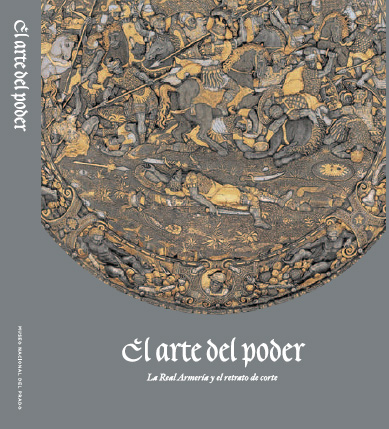
The exhibition is accompanied past a catalogue with two essays plus an introduction by the curator, Álvaro Soler del Campo, Chief Curator of the Royal Armoury, Madrid (Patrimonio Nacional).
The 2 essays in the catalogue are fundamental for an understanding of the development and function of portraits based on the collection of the Royal Armoury in Madrid. They have been written past Miguel Falomir, Head of the Department of the Italian Painting at the Prado, and by Carmen García-Frías.
The catalogue likewise contains entries for all the works on display. They set out the context in which the works were made, the patron, intended utilize of the work and its principal artistic merits. Each entry has a summary bibliography.
Prólogo y agradecimientos
Álvaro Soler del Campo.
La consideración de las armaduras como obras de arte e imagen del poder en el contexto de la Real Armería, Álvaro Soler del Campo.
Carlos Five, Tiziano y el retrato en armadura, Miguel Falomir
La Real Armería en el retrato español de corte, Álvaro Soler del Campo.
Imágenes para la glorificación del poder político. La fortuna del retrato en armadura en los palacios de la casa de Austria española,Carmen García-Frías Checa.
Catálogo.
Índice onomástico.
Bibliografía.
- Title
- The Fine art of Power. The Royal Armoury and court portraiture
- Pages
- 280
- Measures
- 30 ten 24 cm
- Binding
- Paperback
- ISBN
- 978-84-8480-191-7
- Year
- 2010
- Coordinator
- Publishing Section Museo Nacional del Prado, Conservation Department Patrimonio Nacional, Communications Department and Institutional Relations SEACEX
- Design
- Bruma
- Production
- Tf editores
Print on demand
Print artworks available in our catalogue in loftier quality and your preferred size and stop.
Image annal
Request artworks available in our catalogue in digital format.
Source: https://www.museodelprado.es/en/whats-on/exhibition/the-art-of-power-the-royal-armoury-and-court/41c17072-f29b-41b5-b0a1-2a7d45d4f8e4
0 Response to "The Art of Power The Royal Armoury and Court Portraiture"
إرسال تعليق